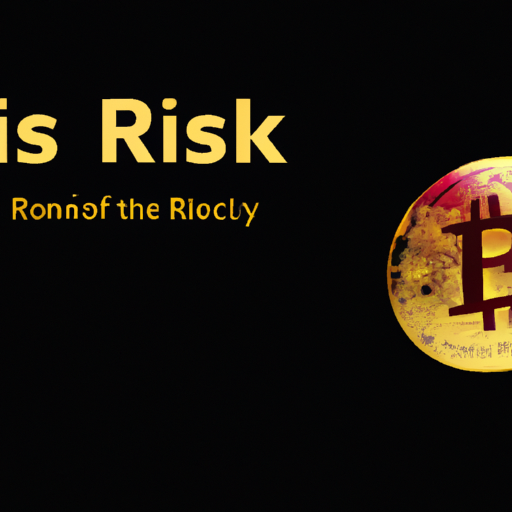When it comes to investing in gold, understanding your risk appetite is crucial for finding your comfort zone. If you’ve been in the game for many years, you understand that gold is often considered a safe-haven asset, serving as a hedge against inflation and economic uncertainties. But knowing how much risk you’re willing to tolerate can help you make informed decisions and protect your investments. In this article, we’ll explore the concept of risk appetite and how it relates to investing in gold. So grab a cup of coffee and get ready to dive into the world of risk and gold!
Understanding Risk Appetite
Definition of Risk Appetite
Risk appetite refers to an individual’s or entity’s willingness and capacity to withstand potential losses or uncertainties in pursuit of an investment opportunity. It is essentially the level of risk that a person or organization is comfortable taking on in order to achieve their financial objectives. Risk appetite can vary greatly among individuals and is influenced by a range of factors.
Factors Influencing Risk Appetite
Several factors can influence a person’s risk appetite. These include their financial goals, time horizon, investment knowledge and experience, income level, and personal circumstances. For example, someone with a long-term investment horizon and high income might be more willing to take on higher levels of risk, while someone with a short-term horizon and limited income might opt for lower-risk investments.
The individual’s risk tolerance, or their psychological willingness to endure uncertainty or potential losses, also plays a significant role in determining risk appetite. Some individuals may have a higher tolerance for risk and are comfortable with the possibility of losing a portion of their investment, while others may have a lower tolerance and prefer more conservative, low-risk investments.
Determining Your Risk Appetite
To determine your risk appetite, it is essential to assess your financial goals, investment knowledge, and tolerance for risk. Ask yourself questions such as: What are you hoping to achieve with your investments? How much risk are you willing to take on to reach those goals? Are you comfortable with potential fluctuations in the value of your investments? These questions can help you gain a better understanding of your risk appetite.
It is also crucial to consider your time horizon, as longer-term goals may allow for increased risk-taking, while short-term goals may require more conservative investment approaches. Additionally, seeking advice from financial professionals can provide valuable insights and assist in determining the most suitable risk appetite for your specific circumstances.
The Importance of Risk Appetite in Gold Investment
Why Risk Appetite Matters
Understanding your risk appetite is crucial when it comes to making investment decisions, particularly in the context of gold investments. Gold, although considered a relatively stable asset, is still subject to market fluctuations and risks. By aligning your risk appetite with gold investment, you are better positioned to make informed decisions and have realistic expectations about potential gains and losses.
Implications for Gold Investment
Different individuals will have different levels of risk appetites that can influence their approach to gold investment. Those with a higher risk appetite may be more comfortable investing in high-risk, high-potential-return gold investments such as mining stocks or futures contracts. On the other hand, individuals with a lower risk appetite may prefer safer options like gold bullion or mutual funds.
Balancing Risk and Return
It is important to strike a balance between risk and return in gold investment. Higher-risk investments may offer the potential for greater returns but also come with a higher likelihood of losses. Lower-risk investments may provide stability but with potentially lower returns. Understanding your risk appetite allows you to find the right balance that aligns with your financial goals and comfort level.
Types of Risk in Gold Investment
Market Risk
Market risk refers to the potential for the value of an investment to decline due to overall market conditions. In the case of gold, market risk can arise from factors such as changes in supply and demand, economic indicators, and investor sentiment. Fluctuations in the value of gold can impact the profitability and returns of gold investments.
Inflation Risk
Inflation risk is the potential for the value of money to erode over time due to rising prices in the economy. Gold is often seen as a hedge against inflation as its value typically rises during periods of economic uncertainty or inflationary pressures. However, there is still a degree of risk involved as gold prices can also be influenced by other factors.
Liquidity Risk
Liquidity risk refers to the possibility of not being able to quickly and easily convert an investment into cash without incurring substantial losses. While gold is generally considered a liquid asset, there may be times when market conditions or other factors affect its liquidity. It is important to consider liquidity risks when investing in gold, especially if there is a need for immediate access to funds.
Political and Geopolitical Risk
Political and geopolitical risks arise from changes in government policies, regulations, or geopolitical events that can impact the value of gold. Factors such as trade disputes, geopolitical tensions, or changes in mining regulations can influence the price of gold and affect the profitability of gold investments.
Currency Risk
Currency risk refers to the potential for fluctuations in currency exchange rates to impact the value of an investment. Gold is often denominated in U.S. dollars, so fluctuations in the value of the dollar can affect the price of gold for investors in different currencies. Currency risk should be taken into account when considering gold investments.
Interest Rate Risk
Interest rate risk is the potential for changes in interest rates to impact the value of an investment. Gold, being a non-yielding asset, is influenced by interest rate movements. When interest rates rise, it can negatively impact the attractiveness of gold as an investment, potentially leading to a decline in its value.
Benefits of Gold as an Investment
Historical Performance of Gold
Gold has a long history of being a valuable and sought-after precious metal. Over the years, it has demonstrated the potential for substantial price appreciation, making it an attractive investment option for many investors. The historical performance of gold highlights its ability to preserve wealth and provide long-term capital appreciation.
Diversification
Including gold in an investment portfolio can provide diversification benefits. Gold’s price movements have historically shown little correlation with other asset classes such as stocks and bonds. By adding gold to a portfolio, investors can potentially reduce overall portfolio risk and increase the potential for risk-adjusted returns.
Hedge against Inflation
Gold is often considered a hedge against inflation due to its ability to hold its value over time. During periods of inflation or economic uncertainty, the value of gold tends to rise, thereby preserving purchasing power. Adding gold to an investment portfolio can provide a safeguard against the erosion of wealth caused by inflation.
Safe-Haven Asset
Gold is commonly regarded as a safe-haven asset, particularly during times of economic or geopolitical instability. It is seen as a store of value that provides stability and acts as a refuge in turbulent market conditions. Investors often turn to gold as a means of preserving capital and reducing the overall risk of their portfolio.
Liquidity
Gold, particularly in the form of bullion or exchange-traded funds (ETFs), offers investors a high level of liquidity. The ability to buy and sell gold quickly and easily allows investors to access their funds when needed and take advantage of potential market opportunities. The liquidity of gold makes it a popular choice among investors looking for flexibility in their investments.
Determining Your Risk Tolerance
Understanding Risk Tolerance
Risk tolerance refers to an individual’s ability to handle and cope with potential losses in their investments. It is a psychological factor that varies among individuals and can influence the investment decisions they make. Understanding your risk tolerance is crucial in aligning your investment strategy with your comfort level and financial goals.
Methods to Assess Risk Tolerance
There are several methods to assess risk tolerance, including questionnaires and assessments provided by financial institutions and investment professionals. These tools typically ask a series of questions to gauge an individual’s willingness to take on risk and their ability to handle potential losses. The results of these assessments can help guide investment decisions and create a suitable risk-appropriate portfolio.
Evaluating Your Financial Goals
When determining your risk tolerance, it is essential to evaluate your financial goals and how they align with your willingness to take on risk. Consider the time horizon of your goals, such as short-term or long-term objectives, and how much risk you are comfortable taking to achieve those goals. A thorough evaluation of your financial goals can provide valuable insights into your risk appetite.
Considering Your Investment Horizon
Your investment horizon, or the length of time you are willing to hold your investments, can also impact your risk tolerance. Shorter-term investments may require a more conservative approach with lower levels of risk, while longer-term investments may accommodate a higher level of risk due to potential for higher returns over time. Understanding your investment horizon is essential when determining the level of risk you are comfortable taking on.
Aligning Your Risk Appetite with Gold Investment
Matching Risk Appetite with Types of Gold Investments
When it comes to gold investment, understanding your risk appetite can help guide your investment decisions. Different types of gold investments carry varying degrees of risk, and aligning your risk appetite with suitable options is crucial for a successful investment strategy.
Gold Bullion and Coins
Investing in physical gold, such as gold bullion and coins, is generally considered a low-risk option. It provides investors with the opportunity to own tangible assets with inherent value. Gold bullion and coins are typically less volatile and offer stability, making them suitable for investors with a lower risk appetite.
Gold ETFs and Mutual Funds
Gold exchange-traded funds (ETFs) and mutual funds provide exposure to the price movements of gold without the need for physical ownership. These investment vehicles offer a higher level of liquidity and diversification compared to owning physical gold. They can be well-suited for investors with a moderate risk appetite seeking a balance between risk and return.
Gold Mining Stocks
Investing in gold mining stocks can offer the potential for higher returns but also introduces additional market and operational risks. Mining stocks are influenced by various factors such as management decisions, production costs, and geopolitical risks. This type of investment is generally considered higher risk and may be suitable for investors with a higher risk appetite.
Gold Futures and Options
Gold futures and options involve contracts to buy or sell gold at a predetermined price and future date. Trading in gold futures and options carries a higher level of risk and complexity compared to other forms of gold investments. It requires a good understanding of market dynamics and is typically more suitable for experienced investors with a high-risk appetite.
Gold Jewelry and Collectibles
Investing in gold jewelry and collectibles can be considered a unique form of gold investment. While these items offer aesthetic value, they may not provide the same investment benefits as other forms of gold investments. Jewelry and collectibles carry additional risks such as storage and transaction costs, as well as the potential for subjective valuation. They may be more suitable for individuals with a personal preference for physical gold assets rather than those strictly seeking investment returns.
Strategies for Managing Risk in Gold Investment
Diversification
One of the key strategies for managing risk in gold investment is diversification. By spreading investments across different asset classes and types of gold investments, investors can reduce the impact of potential losses from any single investment. Diversification helps to minimize risk and enhance the potential for overall portfolio stability.
Asset Allocation
Determining the appropriate allocation of assets in a portfolio is crucial for managing risk. Balancing investments across various asset classes, including gold, stocks, bonds, and cash, can help mitigate risk and maximize potential returns. The specific allocation should consider an individual’s risk tolerance, financial goals, and investment horizon.
Regular Monitoring and Financial Reviews
Regular monitoring and periodic financial reviews are essential for managing risk in gold investments. By staying informed about market conditions and the performance of gold investments, investors can make informed decisions and take necessary actions to mitigate potential risks. Regular reviews also allow for adjustments to the investment strategy, if needed, to align with changing market dynamics.
Setting Realistic Expectations
Setting realistic expectations is crucial to managing risk in gold investment. Gold, like any other asset, can experience fluctuations in its value. By understanding historical performance and recognizing that short-term volatility is a normal part of the investment journey, investors can avoid reacting impulsively to market fluctuations and remain focused on their long-term objectives.
Utilizing Stop-Loss Orders
Using stop-loss orders is a risk management technique that can help protect capital and limit potential losses. Stop-loss orders automatically trigger a sale of an investment when it reaches a specified price, helping to prevent further losses if the value of the investment declines. This strategy can be particularly useful for investors seeking to safeguard against abrupt market downturns.
Seeking Professional Advice
Consulting with Financial Advisors
Seeking advice from financial advisors is highly recommended when it comes to managing risk in gold investment. Financial advisors can provide valuable insights, personalized recommendations, and help navigate the complexities of the gold market. They have the expertise to assess individual risk appetites and align investment strategies accordingly.
Researching Investment Firms
Before engaging with any investment firm, it is crucial to conduct thorough research. Look for firms with a solid track record, experienced investment professionals, and a strong reputation. Understanding the firm’s investment philosophy and approach to risk management can help ensure a suitable match for your risk appetite and investment goals.
Using Online Resources
Online resources can be a valuable tool for individuals seeking information and insights into gold investment and risk management strategies. There are numerous reputable financial websites, research platforms, and educational resources available that provide valuable information and analysis on gold investments. However, it is essential to critically evaluate the sources and ensure that the information is reliable and up-to-date.
Joining Investment Communities
Joining investment communities, such as online forums or local investment clubs, can provide opportunities to connect with like-minded individuals and share insights on risk management and gold investment strategies. These communities can offer a platform for exchanging ideas, discussing market trends, and learning from the experiences of others. However, it is important to approach these communities with a critical mindset and verify the information received.
Risk Mitigation and Exit Strategies
Setting Stop-Loss Limits
Setting stop-loss limits is a risk mitigation strategy that allows investors to protect their investments from excessive losses. By determining a predetermined price at which they will sell their gold investment, investors can ensure that their losses are limited to a specific percentage or dollar amount. Stop-loss orders can be particularly useful in managing risk during market downturns or unexpected events.
Identifying Early Warning Signs
Identifying early warning signs is crucial for managing risk in gold investment. By staying informed about market trends, economic indicators, and geopolitical events, investors can anticipate potential risks and take necessary actions to protect their investments. Regular monitoring of news and industry developments can help identify signals that may impact the value of gold.
Adapting to Market Changes
The ability to adapt to market changes is essential in managing risk in gold investment. Markets are dynamic and can experience rapid shifts in sentiment and prices. By staying flexible and adjusting investment strategies in response to market changes, investors can mitigate potential risks and position themselves to take advantage of new opportunities.
Implementing Hedging Strategies
Hedging strategies involve taking positions that offset potential losses in existing investments. In the context of gold investment, this can include utilizing futures contracts, options, or other derivative instruments to mitigate downside risk. Hedging can be complex and requires a good understanding of the market and the specific investment instruments being used.
Knowing When to Exit a Position
Knowing when to exit a gold investment is a key aspect of managing risk. This requires identifying the appropriate time to sell in order to secure profits or limit potential losses. Investors should consider factors such as market conditions, investment objectives, and changes in risk appetite when determining the right time to exit a position.
Conclusion and Final Thoughts
Understanding Your Risk Appetite
Understanding your risk appetite is essential for successful gold investment. By assessing your financial goals, investment knowledge, and tolerance for risk, you can align your investment strategy with your comfort level and maximize the potential for achieving your objectives.
Finding Balance in Gold Investment
Balancing risk and return is crucial when investing in gold. By understanding the different types of risks associated with gold investment and aligning them with your risk appetite, you can strike a balance that aligns with your financial goals and comfort level.
Continual Learning and Adaptation
Investing in gold, like any other asset class, requires continual learning and adaptation. Markets evolve, and new risk factors emerge over time. By staying informed, seeking professional advice, and continuously evaluating and adjusting your investment strategy, you can effectively manage risk and increase your chances of success in gold investment.



